#some kind of wasp-mimic flies?
Explore tagged Tumblr posts
Text

#naruto#naruto fanart#kiba inuzuka#akamaru#shino#shino aburame#aburame shino#team 8#dai-hachi-han#bugs#insects#flies#some kind of wasp-mimic flies?
73 notes
·
View notes
Note
terribly sorry if this is a weird question but i would LOVE to hear more about wasps . funky little dudes

wasps are a relatively new species in terms of insect evolution, having appeared in the jurassic period alongside the first dinosaurs. there are hundreds of thousands of species, which could include ants and bees depending on your exact definition. they're all included in the group apocrita, or the "wasp waisted" hymenoptera. they are some of the most successful insects on the planet.
DID YOU KNOW?: the stinger of apocrita is a highly adapted ovipositor, the organ used for egg laying.
STEP ONE: their ancestors, the sawflies, had evolved a serrated ovipositor that could bore into plant material as a safe place to lay their eggs.
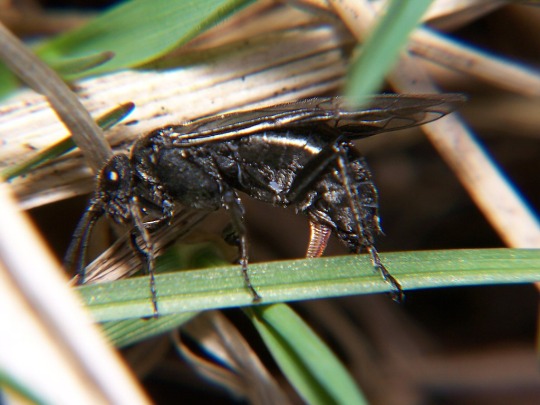

STEP TWO: the first wasps would use the ovipositor to instead lay their eggs inside of other animals (parasitoidism), which then provides the developing young plenty of food. many of these wasps would develop a unique variety of venoms to aid in the capture of prey, often by paralysis.
DID YOU KNOW?: there are more parasitoid wasps than any other kind of wasp, with an estimated 100,000 species! this includes the iconic cicada killer wasp.
STEP THREE: the transition from egg laying to defense is not entirely understood, but is believed by some to have been a direct response to predation by vertebrates. if you think about it, it's not all that easy to sting through a tough exoskeleton (though it can be done), it's much easier to sting soft, fleshy things that are trying to eat your delicious grub children. these wasps no longer lay eggs with the ovipositor, instead having an opening at the base of the stinger. the venom would be adapted to illicit a pain response, a harsh lesson to not mess with wasps!
DID YOU KNOW?: male wasps CANNOT sting as they do not have an ovipositor. though, some males will still mimic stinging, or even have pointed abdomens to help sell the illusion.
QUICKFIRE ROUND:
while wasps are famously eusocial and will often live in large communal hives, the vast majority of wasps are solitary and live on their own.
the largest species of wasp is the northern giant hornet, who's queens are around 2 inches in length. the smallest species of wasp is also the smallest insect ever! dicopomorpha echmepterygis males have been measured as small as 139 micrometres in length.
its common knowledge that wasps can sting multiple times and honey bees cant. this is a unique adaptation of the honey bee, who deliver a more potent sting by leaving the stinger embedded in the victim as it continues to pump rounds and rounds of venom. unfortunately, the stinger is directly attached to many vital organs, which are then damaged in the process, causing the honey bee to die.
insects breathe by absorbing oxygen directly into their "blood". wasps aid in this by rapidly expanding and collapsing their abdomen to force air in and out. if her butt is vibrating, shes just taking a breath :)

the iconic coloration of the wasp, usually yellow and black, is part of their defensive strategy! this is a form of aposematism, the advertising of danger to potential predators. they want you to notice them, so you know to steer clear!
the coloration is SO iconic that thousands of insect species mimic it in hopes of also warding off predators. this includes flies, moths and butterflies, and even their own ancestors, the sawflies.
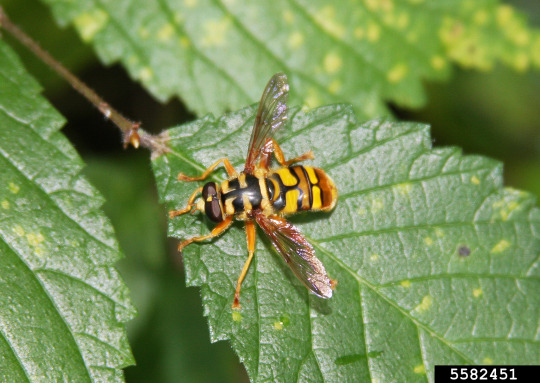

parasitoid wasps are very specific in their choice of prey, likely due to the unique cocktail of venom they must possess to influence any given species. for any arthropod, there is a species of wasp that specializes in parasitizing THAT specific arthropod.
because i know some people are wondering, the venom of parasitoid wasps can only effect arthropods, there will be no wasp based mind control within the next few million years. some parasitoids have been known to sting defensively, which is still quite painful depending on the exact species.
some wasps are HYPERPARASITOIDS, meaning they will lay their eggs on other parasitoids that are already parasitizing something. its parasitoids all the way down.
one of these hyperparasitoids is the velvet ant. despite it's common name, they're actually a species of wasp with flightless females. the males do possess wings, and in some species, will assist the female by carrying her to an environment with better resources.
the venom of gall wasps will, when inserted into a tree or other vegetation, cause it to grow a mass, known as a gall. basically a bootleg fruit, filled with nutrients. these wasp galls will then safely house the wasp's young which eat it from the inside out, before emerging as adult wasps.
obviously, theres wasps that parasitize the gall wasps inside the gall.
fig wasps are the only animals that can pollinate figs, and do so by crawling inside to lay their eggs before dying inside the fruit. well, the only animal other than humans, which find figs quite tasty but don't typically enjoy eating dead wasps.
i probably wont ever get a better opportunity to share this information, sorry: the queen honey bee mating with a drone is audible to the human ear, making a popping sound. the drone's endophallus (penis) is violently detached in the process and he dies soon after.
lastly, lets just marvel at the beauty of the wasp. they have some of the most striking appearances of any animals on earth.
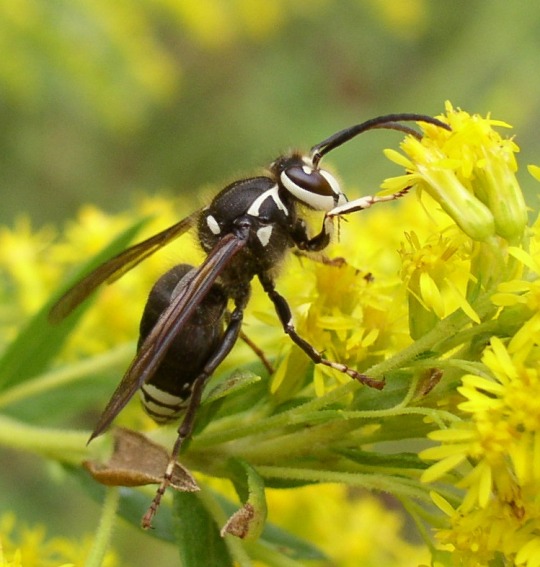





i am just fillled with awe when i look at them. a powerful and intimidating predator that takes great care in raising the next generation. perhaps my favorite animal.
#SORRY. YOU HAVE ACTIVATED HYMENOPTERA SPECIAL INTEREST MODE.#corrections: i say 'species' when i mean 'group' a lot. also i mixed up jurassic and triassic dinosaurs had already been around for awhile
164 notes
·
View notes
Text
How to Get Into Bugs

"A world of dreams and adventures with bugs awaits! Let's go!"
What are bugs? In this document when I say “bugs”, I refer to small invertebrate animals like insects, spiders, snails, and worms. These creatures are underappreciated, and their importance to the health and function of life on Earth cannot be overstated. Bugs aerate the soil, pollinate plants, spread seeds, clean up dead plants and animals, provide food for countless species, prey upon countless others, and cycle nutrients across the planet, among other services.
Bugs are amazing creatures. They come in a vast variety of shapes and colors, from the shining wings of a blue morpho butterfly to the pebble-like body of a toad bug. Their habits and behaviors are just as complex as those of larger animals. Stick insects sway as they walk to mimic a branch blown in the wind, mud dauber wasps gather mud to build earthen nests, and moths read the stars to navigate in the dark. Because they are small, bugs can be supremely adapted to their environment. Many insects will form relationships with specific plants, only pollinating or laying their eggs on these species.
There are many mysteries left to uncover about bugs. Insects alone make up 75% of known animal species, with more being discovered every day. These species are not only being found in remote forests and grasslands, but in woods, parks, and other habitats closer to home. You may be the first to discover a rare creature found only in your area! It is not only new species that present us with mysteries. There is ongoing research into even common species, to answer questions like how flies land upside down, how beetles fold their wings, or how bees make decisions on where to build their nests.
If you appreciate them, the world will become more vibrant. Wherever you are, you can almost certainly find bugs. By noticing these creatures living around you, you will become more aware of nature not as an untouched ideal found only in mountain rainforests or ocean trenches, but as the life that permeates even the most “average” places.

How Can I Get into Bugs?
Go for a walk! As you are walking, take the time to look closely at your surroundings. Notice the different species of insects you see flying around. Look at the leaves and branches of plants. Turn over rocks and bricks. Do you see any bugs? Focus on one of the animals you see. What is it doing? Searching for food? Resting? Building a nest? Have you ever seen this bug before? What is it called? What is its life cycle like? These questions provide starting points that you can use to learn about the creatures that live alongside you.
Get acquainted through books, websites, and videos! Field guides and websites like iNaturalist serve as great first steps to familiarizing yourself with the species found in your area. Select a favorite species or family of bugs, then go out to search for them in the wild. Online resources can also be used to overcome phobias. If you find yourself creeped out by an animal, you can look up videos online to get used to its appearance and movements.
Gather some useful gear! If you are looking to catch bugs for photography or collection, you'll want to have a jar of some kind to contain them. Mason jars work well for large specimens and 2 oz. travel sized jars work well for smaller animals. Flying insects like moths and dragonflies can be captured with a butterfly net, while sweep nets can be brushed against vegetation to collect crawling animals. Dip nets are made for use in water and can be used to capture shrimp and snails along with aquatic insects. In addition to bug-specific equipment you may want gear like a bookbag, sunscreen, hiking boots, canteen, and long pants if you are going out into wilder areas.
Know where to look! Different species of animals need different resources to survive, so they will be found in different places. Look beneath logs or dead leaves to find isopods, millipedes, and earthworms. Ponds and other water bodies are often home to water skaters, crayfish, and water beetles. Flowering plants are a good place to find bees, butterflies, and wasps. Caterpillars, aphids, and planthoppers can often be found on leaves and branches. Some species of insects can only be found on particular plants. Whenever you find a new plant species, take a closer look to see what is living on it. Also be aware of what time you go out searching. If you go to the same location during the day and night, different creatures will be active.
Keep a record of your adventures! Whether it be a digital photo album, a collection of preserved insects, or a written diary, records will provide you with an easy way to revisit memories of your exploits. You might also have more fun exploring the world of bugs if you have a personal project to develop.
Raise bugs in captivity! Caterpillars and beetles can be raised over a season and released when they undergo metamorphosis. Snails and isopods are easy to keep so long as they are fed vegetable scraps and have humid places to hide in their enclosure. Many insects, spiders, snails, and other invertebrates are easy to care for in vivariums. Just be sure not to overcollect! While many bugs have healthy populations, others need as many wild breeding individuals as possible. Entirely avoid collecting endangered species or taking animals from protected areas.

Help Your Local Environment!
Insects, arachnids, and other invertebrates serve as essential building blocks to the global ecosystem and help to keep our world functioning. There are many ways you can help bugs:
If you enjoy gardening or landscaping, grow some plants native to your area. Native plants provide local species with food and shelter, and because they are adapted to your habitat, often require less care than exotic plants.
Avoid spraying pesticides and herbicides unless truly necessary. Not only can these substances kill off non-target species, they can also increase the populations of pesticide-resistant species, runoff from their site of application, and seep into local soil and water supplies.
Select a woodland, meadow, or section of waterway and keep it clean of litter. Pollution may be a global issue, but the world is made up of places, and you can make tangible change in your local area. See if you can get some friends together to help out. Cleanup efforts are most enjoyable with a few extra hands!
You can protect your local woods, creeks, or other wilderness spaces by working with your community’s hobbyists and environmental organizations, learning about your local ecosystem, and sharing your thoughts with others.
Many of the environmental, societal, and health issues we face are interconnected. Thus, improving one situation will make it easier to address others. Whatever problem you are most equipped to face, do your best. Even the smallest action you can take changes the future and makes it that much better.
Online Resources
https://www.inaturalist.org/observations/ - Explore worldwide observations of living things.
https://xerces.org - The Xerces Society for Invertebrate Conservation is an international nonprofit organization that protects the natural world through the conservation of invertebrates and their habitats.
https://en.wikipedia.org/wiki/Portal:Arthropods - Wikipedia information on arthropods, their habits, and biology.
https://bugguide.net/node/view/15740 - Information on bugs from the United States and Canada.
https://www.pbs.org/show/deep-look/ - Explore big scientific mysteries by going incredibly small.
Chromatophone Nature Youtube Channel – No-Commentary wildlife footage, like a virtual nature walk.
Thank you for reading! For a PDF version of this post, visit my blog an check the pinned post.
48 notes
·
View notes
Text
The biology teacher talked about camouflage and mimicry in animals yesterday.
I’m interested.
There are different types of camouflage. Mimicry is one of them. This is when an animal looks like another animals or something gross. Mimicry sometimes also is when an animal sounds like something else. For example, there is a moth that mimics the sound of a tiger moth because those are not really tasty.
You also have examples of moths that look like a broken twig, a caterpillar pretending to be a venomous snake and a butterfly looking like a leaf. Maybe you see a pattern here. It’s a lot of butterflies and moths. Other insects do it too! For example hover flies and stick bugs mantises. And we all know those smaller wasps, right? Well, those are the, completely harmless, hover flies! They use this to not get attacked by humans.
Octopi also use camouflage! (Only one species though, this species is called the mimicry octopus)When they swim over the ocean ground they let their tentacles free after them too look like some kind of flat fish. When they’re swimming normally/up the octopi also let their tentacles go free. They do this to look like a lion fish. When the octopi are resting or sleeping they bury themself under the sand. The octopi let their two of their tentacles go free to make it seem like a very venomous snake.
The hawk-moth caterpillars also ‘use’ batesian mimicry. They have adapted themselves to look like highly venomous snakes. They do this because well, they’re caterpillars- they’re quite big too.
The mimicry of octopi and other creatures looking like dangerous animals is called batesian mimicry.
There is also acoustic mimicry. This is when animals sound like another animal. I’ve talked about one moth sounding like another (tiger) moth, right? Well, other animals do this too.
Several species of spiders mimic ants. Though this is not as handy as you might think. They have a smaller waist and therefor can carry less egg sacs. They don’t reproduce as much as other spiders do.
Then we have Emsleyan mimicry. This is when a dangerous animal mimics a less or non dangerous animal. I actually cannot find or understand the explanation to this. So I apologise for that.
Now we’re going to my favourite type of mimicry. Aggressive mimicry. This is the wolf’s in sheep’s clothing approach where an animal looks like prey or has a limb that looks like prey.
Two of my favourite examples here are the alligator snapping turtle and the spider-tailed horned viper.
The alligator snapping turtle will hang out underwater and open it’s mouth. Snapping turtles have a tongue that they can move to represent a worm. The snapping turtles will just wait, unmovingly, for an animal to be stupid enough to try and eat the ‘worm’ in the mouth of the snapping turtle.

No thank you.
Now, onto the spider-tail horned viper. This snack or viper has a weird looking tail. The snake itself will hide/camouflage with some rocks and move its tail to mimic a moving spider. The first time I saw a video I was convinced it was a spider, till I saw something fly to it to try and eat the spider and I saw a snake jump out of there to grab it.
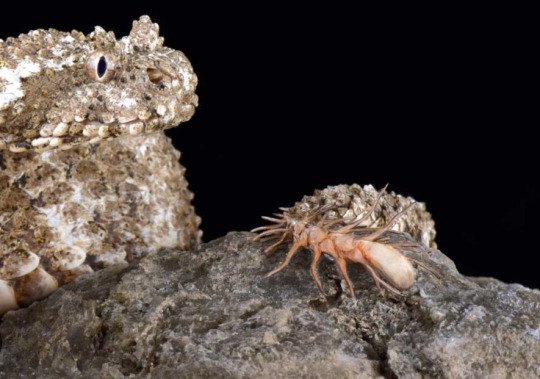
Unbelievable, right?
I already talked about how mantises can look like ants, right? (If not, they can)
There are mantises that look like flowers. Let’s take the orchid mantis as example for this. They use this as hunting camouflage. They climb up an orchid and sit next to the flower to then wait for a prey to come. It’s really cool and they are also very beautiful.
They of course are also different mantises. Some look like leafs and also dead leafs.
And that is all for now! Have a good day!
#animal facts#fun facts#fun facts with idi#mantises#camouflage#agressive camouflage#animal camouflage#snakes#turtles#spiders
22 notes
·
View notes
Text
Flowers again
Pollination biology furnishes us with some pretty amazing facts, and the high point of wondrousness is reached in the orchids. No wonder Darwin was so keen on them; no wonder he wrote the book I have already mentioned, The Various Contrivances by which Orchids are Fertilised by Insects. Some orchids, such as the 'magic bullet' Madagascar ones we met earlier, give nectar, but others have found a way to bypass the costs of feeding pollinators, by tricking them instead. There are orchids that resemble female bees (or wasps or flies) well enough to fool males into attempting to copulate with them. To the extent that such mimics resemble females of one particular insect species, to that extent will males of those species serve as magic bullets, going from flower to flower of just the one orchid species. Even if the orchid resembles 'any old bee' rather than one species of bee, the bees that it fools will still be 'fairly magic' bullets. If you or I were to look closely at a fly orchid or a bee orchid (see colour page 5), we would be able to tell that it was not a real insect; but we would be fooled at a casual glance out of the corner of our eye. And even looking at it head-on, I would say the bee orchid in the picture (h) is pretty clearly more of a bumble-bee orchid than a honey-bee orchid. Insects have compound eyes, which are not so acute as our camera eyes, and the shapes and colours of insect-mimicking orchids, reinforced by seductive scents that mimic those of female insects, are more than capable of tricking males. By the way, it is quite probable that the mimicry is enhanced when seen in the ultraviolet range, from which we are cut off.
The so-called spider orchid, Brassia (colour page 5 (k)), achieves pollination by a different kind of deception. The females of various species of solitary wasp ('solitary' because they don't live socially in large nests like the familiar autumn pests, called yellowjackets by Americans) capture spiders, sting them to paralyse them, and lay their eggs on them as a living food supply for their larvae. Spider orchids resemble spiders sufficiently to fool female wasps into attempting to sting them. In the process they pick up pollinia - masses of pollen grains produced by the orchids. When they move on to try to sting another spider orchid, the pollinia are transferred. By the way, I can't resist adding the exactly backwards case of the spider Epicadus heterogaster, which mimics an orchid. Insects come to the 'flower' in search of nectar, and are promptly eaten by it.
Some of the most astonishing orchids that practise this seduction trick are to be found in Western Australia. Various species in the genus Drakaea are known as hammer orchids. Each species has a special relationship with a particular species of wasp of the type called thynnids. Part of the flower bears a crude resemblance to an insect, duping the male thynnid wasp into attempting to mate with it. So far in my description, Drakaea is not dramatically different from other insect-mimicking orchids. But Drakaea has a remarkable extra trick up its sleeve: the fake 'wasp' is borne on the end of a hinged 'arm', with a flexible 'elbow'. You can clearly see the hinge in the picture (colour page 5 (g)). The fluttering movement of the wasp gripping the dummy wasp causes the 'elbow' to bend, and the wasp is dashed repeatedly back and forth like a hammer against the other side of the flower - let's call it the anvil - where it keeps its sexual parts. The pollinia are dislodged and stick to the wasp, who eventually extricates himself and flies off, sadder but apparently no wiser: he goes on to repeat the performance on another hammer orchid, where he and the pollinia he bears are duly dashed against the anvil, so that his cargo finds its destined refuge on the female organs of the flower. [...]
In the same lecture I discussed the 'bucket orchids' of South America, which achieve pollination in an equally remarkable but rather different way. They too have specialized pollinators, not wasps but small bees, of the group called Euglossine. Again, these orchids provide no nectar. But the orchids don't fool the bees into mating with them either. Instead, they provide a vital piece of assistance for male bees, without which the bees would be unable to attract real females. These little bees, which live only in South America, have a strange habit. They go to elaborate lengths to collect fragrant, or anyway smelly, substances, which they store in special containers attached to their enlarged hind legs. In different species these smelly substances can come from flowers, from dead wood, or even from faeces. It seems that they use the gathered perfumes to attract, or otherwise court, females. Many insects use particular scents to appeal to the opposite sex, and most of them manufacture the perfumes in special glands. Female silk moths, for example, attract males from an astonishingly long distance by releasing a unique scent, which they manufacture and which males detect - in minute traces from literally miles away - with their antennae. In the case of Euglossine bees, it is the males that use scent. And, unlike the female moths, they don't synthesize their own perfume but use the smelly ingredients that they have collected, not as pure substances but as carefully concocted blends which they put together like expert perfumiers. Each species mixes a characteristic cocktail of substances gathered from various sources. And there are some species of Euglossine bee that positively need, for manufacturing their characteristic species scent, substances that are supplied only by flowers of particular species of the orchid genus Coryanthes - bucket orchids. The common name of Euglossine bees is 'orchid bees'.
What an intricate picture of mutual dependence. The orchids need the Euglossine bees, for the usual 'magic bullet' reasons. And the bees need the orchids, for the rather weirder reason that they can't attract female bees without substances that are either impossible or at least too hard to find except through the good offices of bucket orchids. But the way in which pollination is achieved is even weirder still, and it superficially makes the bee look more like a victim than a cooperating partner. A male Euglossine bee is attracted to the orchids by the smell of the substances that he needs in order to manufacture his sexual perfumes. He alights on the rim of the bucket and starts to scrape the waxy perfume into the special scent pockets in his legs. But the rim of the bucket is slippery underfoot - and there's a reason for this. The bee falls into the bucket, which is filled with liquid, in which he swims. He cannot climb up the slippery sides of the bucket. There is only one escape route, and this is a special bee-sized hole in the side of the bucket. He is guided by 'stepping stones' to the hole and starts to crawl through it. It's a tight fit, and it becomes even tighter as the 'jaws' contract and trap him. While he is held in their grip, they glue two pollinia to his back. The glue takes a while to set, after which the jaws again relax and release the bee, who flies off, complete with pollinia on his back. Still in search of the precious ingredients for his perfumery, the bee lands on another bucket orchid and the process repeats itself. This time, however, as the bee struggles through the hole in the bucket, the pollinia are scraped off, and they fertilize the stigma of this second orchid. The intimate relationship between flowers and their pollinators is a lovely example of what is called co-evolution - evolution together.
Co-evolution often occurs between organisms that have something to gain from each other, partnerships in which each side contributes something to the other, and both gain from the cooperation. Another beautiful example is the set of relationships that have grown up around coral reefs, independently in many different parts of the world, between cleaner fish and larger fish. The cleaners belong to several different species, and some are not even fish at all but shrimps - a nice case of convergent evolution. Cleaning, among coral-reef fish, is a well-established way of life, like hunting or grazing or anteating among mammals. Cleaners make their living by picking parasites off the bodies of their larger 'clients'. That the clients benefit has been elegantly demonstrated by removing all the cleaners from an experimental area of reef, whereupon the health of lots of species of fish declines. I have discussed the cleaning habit elsewhere, so will say no more here.
Co-evolution also occurs between species that don't benefit from each other's presence, like predators and prey, or parasites and hosts. These kinds of co-evolution are sometimes called 'arms races' and I postpone discussing them to Chapter 12.
— Richard Dawkins, The Greatest Show on Earth
0 notes
Text

masks are parasitic organisms of some kind of supernatural nature. theyre kind of whatever you want them to be (haunted/cursed object, living animal, bioweapon, alien, fucking Thing, etc)
the mimics, however, are both highly social and highly territorial ambush predators/scavengers with generally short lifespans, though they also act as highly aggressive persistence hunters when their host body is on the verge of giving out and they're driven to want to multiply as much as possible. they tend to be very friendly to those of their own "group" (usually other mimics that were turned along with them or by them) but anyone else is reacted to usually with hostility or predatory intent. their intelligence is typically somewhere in between that of a human and that of other intelligent non-sapient animals. some groups independently develop tool use or rudimentary language, but it's not widespread amongst the greater population. those who still have intact faces under their masks often emote with them in a strange mix of human-like and animal-like ways. thing that threat-smiles at you.
they're specialized predators and parasites of humanoids, modifying the host biology into an unfeeling acid generator that doubles as a form of aggressive mimicry; they're incapable of feeling pain anywhere besides their masks (their temperature sense is also dulled) and their stomach acid is converted into a potent, oxidative acid that melts flesh similarly aggressively to piranha solution. the reaction that occurs in their gut is highly exothermic, making them surprisingly warm as well. their saliva is very mucosal and alkaline to protect their throat and mouth in return. after a while once the host body dies and starts deteriorating they're likely to start dissolving from the inside out.
tragedy mimics are often much rarer, though hypothetically are the more common type as the comedy state is more of a transient, hyperaggressive state that's brought on usually when focusing on prey or potential new infectees--the mask floods the body with lots and lots of serotonin and dopamine as part of a sort of 'hunting high.' outside of this state they're surprisingly chill but also much more likely to kill AND eat you as opposed to converting you into another mimic. they're also perfectly fine with cannibalism.
if somehow you manage to not get hunted for sport by a frenzied mimic or eaten by a normal one they're actually very curious. but good luck finding that out normally
bonus headcanon: mask hornets get their name from also being hyperparasites of the masks. they're big, swarming, biting flies rather than true wasps.
you should ask ME things about masked biology and behaviors. btw. i think about it a lot
#teehee#lethal company#lethal company masked#also all of their bodily fluids are contaminated with blood#ask to tag
48 notes
·
View notes
Note
Hello I was wondering if you could help me identify a bug that I saw as a kid? This was in California. I remember the bug was fly like and probably imitating a bee or a wasp due to it being yellow with black stripes but no fuzz. It was also huge and my family warned me to stay away from it because it was harmful. I don't think it was some kind of wasp since it looked more like a fly to me but I'm not really that knowledgeable in entomology. I searched it up on the internet and hoverflies came up but I'm not sure if they get as big as I saw it? It could probably fit on the palm of my small child hand. I think about what I saw sometimes but thank you in advance
Hoverflies are generally quite small so I doubt that’s what it was. I’m afraid without seeing it I really can’t say. There are a ton of wasp mimic bugs out there from all different orders of bugs, and many of them aren’t fuzzy. I would say browse the photos here of dipterans (flies) in your area or here for hymenopterans which include wasps.
26 notes
·
View notes
Text
i put coneflowers on my roof space (I live in a 5 story apartment building) and they LOVE IT! Bees also still find them up there and all kinds — bumble bees, carpenter bees, other native solitary bees I don’t know the exact name of, wasps, and I’ve also seen some bee-mimic type flies. Native plants that like lots of sun and poor soil and occasional drought conditions (ie say you forget to go up there and water them for a day or two) are going to LOVE your roof. Give your roof properly insulated garden beds or a container garden with saucers/drip trays under all your containers to prevent water damage to your house!!
Hey everyone! As part of a personal project I’m trying to brainstorm factors that would make communities/locations more resistant to climate change and the damage that it can cause to people’s lives. If anyone has any thoughts I’d love to hear them!
5K notes
·
View notes
Text
A Lewisian Year
Presented in partnership with the Lewisia Communications Board and Lewisia Public Library
Sponsored by The Historical Society
Hello, readers, listeners, and psychic osmosizers! Welcome to A Lewisian Year, a monthly showcase celebrating the rich culture here in the Lake Lewisia district. Each month, we'll highlight some seasonal events, local celebrations and interpretations of national and world holidays, and historical tidbits.
JULY
Firebird Eggs
It's a blazing hot day in the deep of summer, and you, unfortunately, have to go outside. If you were lucky, you would be headed to the lake, where the water keeps the ambient temperature a little lower, or into the woods, where the closeness of the air is offset by the relief of shade. But no. You're headed out to the Hawberry Flats area on the northeast of town, where a spread of glacier-flattened prairie gives the sunshine ample room to bake the grass and the people golden brown.
As you walk, relishing every small patch of shade that crosses your path, you notice a bush up ahead. It's small, and tangled with undergrowth around the base, and gently smoking. You blink and rub the sweat from your eyes. It's probably just heat haze, you think. When you look again, the smoke seems a little thicker, curling steadily upward in the still air.
You get closer to investigate, leaning to look inside. A pulse of heat washes up into your face. Down at the base of the bush, there is a nest built of grass and small sticks--built of tinder--and heaped up around the edges like a well-made campfire. There, in the heart of the fire-to-be, is a single, deep red egg. As you watch, it jostles side to side. And then...it ignites, flame bursting from a crack where the creature inside has started to break out into the world. A new firebird is born.
Not every summer boasts a hatching like this. No one knows for sure what makes a year right for newborn firebirds. (Firebird, phoenix, and sunbird are all commonly used, more or less interchangeably, though you can get a folklorist or a biologist going for hours on the finer points distinguishing the terms.) Heat, certainly, plays a part. It's thought that the slow, uneven incubation of firebirds has something to do with the availability of resources to support them. Not just any environment can sustain a population of large, intermittently flammable, quasi-immortal avians.
Summer Pests
Of course, not all creatures brought out by the heat are as welcome as newly-hatched firebirds. Heat, lack of water, and rapidly dwindling supplies of plant life can drive any number of small pests into homes and yards at this time of year. While we may have sympathy for their plights, it does become difficult to keep that in mind when you catch something scurrying behind the refrigerator every time you turn on the kitchen lights. Outside of Lewisia, people can expect an influx of flies, ants, and mice if they live anywhere near agricultural areas or open fields. Deserts get their visitations of snakes and scorpions. Here, though, the pests can run a bit more exotic, if not necessarily more hazardous.
Salamanders--the flaming kind, not the aquatic ones--start an estimated ten percent of minor brush fires every year. (The aquatic ones are more notorious for engaging in confidence games and small-time grifting.) Parasitic wasps here include dream- and memory-eating varieties, which can make napping while at the family cookout particularly fraught. Nothing can tear up a garden or lawn like an infestation of wolpertingers, which manage to molt, burrow, build nests, and scrape their antlers on anything that stays stationary longer than two minutes.
A particularly hardy clan of house brownies is said to have domesticated a strain of these chimerical garden pests, which I can only imagine comes as a mixed blessing for the humans sharing homes with them. Contracts with fae are not, in fact, the most exotic method used to manage unwanted wildlife. (Fairy knights jousting against a scorpion are a sight to behold, and may be well worth the sacrifice of blood favors.) Some chemical deterrents are available, but most people focus on making their living spaces less inviting to unwanted creatures. Then there are the homes that lean into the aesthetics of their unplanned tenants: the old Birchhead Manor, following its moat expansion, positively revels in the arrival of a fresh crop of Silent Gillmen (Hyla grendeliana) every spring.
Convention Season
If the outdoors are getting you down, you can always head inside to one of the many conventions taking place this summer. With people taking vacations from school and work and the weather generally stable-if-sweltering, summer is the preferred season for conventions. From international book festivals to small-town catch-all pop culture street fairs, almost anywhere is within reasonable travel of almost any interest's yearly gathering.
If there's one thing Lewisians love, it's any kind of celebration of niche interests and fanatical hobbies. Lewisia has previously hosted the Haunted Doll Collectors Society for their national event, multiple years of Weaver Weekend, and alternate years in a shared custody arrangement with the Ghostly Congress for "Afterlife the Convention." Local businesses enjoy the uptick in visitors and local people-watchers enjoy the free show of attendees going to and from the Event Center.
Plenty of conventions hosted away from Lewisia and her sister cities will still see a number of Lewisian attendees. December and January usually see a rush of organizing groups to purchase hotel room blocks and travel tickets as soon as convention badges go up for advance sale. Some of our local artists regularly tour around these outside conventions' Artist Alleys. Three current residents of Lewisia, in fact, owe their first contact with the town and eventual move here to artists at conventions.
Conventions that welcome cosplayers offer a particular advantage to Lewisians with more unusual body types. There has been an informal competition here in town for many years among non-human and semi-humanoid residents to craft elaborate cosplay costumes that allow them to walk in broad daylight among people who have no idea that ambulatory plants or marsupial darkness exist. Divisions within this competition include:
costumes designed to obscure the body entirely (popular with quadrupeds and others with body plans laid out more on the horizontal than the vertical);
costumes based on fictional versions of real species (werewolves and snake- or fish-based creatures leading the field);
and mundane cosplay that tries to accurately mimic standard human features and forms on non-standard bodies (dominated for three years running by a cephalopodic resident with a special knack for textural camouflage).
This Month in History
July 24th, 1999, is the most recent confirmed sighting of the fairy ball in the Lewisia area. While fairies are, obviously, common sights in Lewisia and elsewhere, the fairy ball is something different. No fairy asked about the subject has ever given an answer that consisted of anything other than bald-faced lies and open scorn for the asker. Those present at the time reported seeing wicker chariots pulled by luna moths, hot air balloons propelled by harnessed bats, and sprays of durable soap bubbles with free-floating occupants. All these and other unusual methods of travel headed west over the forest.
Speculation ran rampant at the time: The ball was being held over the ocean. No, it was on the moon, in the secret moon city. It was in response to the millennium coming to an end. No, it happened every year. It was an ill omen, a promise of coming prosperity, a sure sign of rain, drought, or wind, and a "rotten nuisance" to stargazers trying to enjoy a clear night. No one could agree on any of the details, except that it had been seen. A few individuals have claimed to have been spirited away to the fairy ball, though such a story is impossible to prove. All but one acknowledge being eventually returned after the event. The remaining one insisted xie still resides in the secret moon city and politely inquired after my comfort in the moon atmosphere when I interviewed xem.
That's a taste of what July has to offer us. See you next month, when August brings the first harvests and a definitely-not-fictitious return to school.
#fiction#microfiction#magical realism#holidays#history#July#Lake Lewisia#demifiction#A Lewisian Year#bonus material
3 notes
·
View notes
Text
Okay here’s the whole entire text of my original pokemon gen concept under a cut (sorry if that screws you up on mobile)

I’ve only ever sketched a tiny number of these (like my fly ideas here), but I can see most of them in my head pretty clearly and might sketch more of them by request someday. I originally set my fan-region in Florida, a place I hated living but still had a lot of interesting characteristics. This changed over once I moved to Oregon, and the thing about Oregon is that it has desert, forest, swamp, coastline and frozen mountaintops that are all pretty vast, ancient and in places relatively untouched compared to the rest of North America. This is not only a perfect setting for some really wild pokemon, but makes a believable choice because our Pacific Northwest is pretty popular in Japan.
The different biomes of this region have "deep" areas where the pokemon change. Some also have "polluted" areas. The region is environmentally themed and heavily deals with human interference on the natural world.
The villains are Team Bio, genetic engineerers lead by a mysterious old woman who narrowly survived the original Mewtwo experiment. Her underlings all use "mutant" pokemon, and she seeks to create a new species of hyper-intelligent, pure-hearted pokemon that will replace humans entirely. Along the way is a strange increase in reports of interstellar pokemon activity... I actually tried hard to minimize how many pokemon in this are just “my kind” of concept, but I think I failed pretty hard. It probably does feel like it leans a little more towards Mortasheen than something Pokemon would actually make, but for basically every pokemon that’s one of my “dream concepts” or “most wanted” I tried to come up with one that I thought would appeal more to somebody else’s taste than mine.
THE STARTERS
Grass Starter: a grass "lumberjack" pterosaur with an axe for a beak. Second stage has more saw-like beak, final stage is a grass/steel quetzalcoatlus (the pterosaur) with a beak and crest forming a chainsaw, no longer flies
Fire type calf whose black cow marks are actually soot. Evolves into cow with craggy black “helmet” and horns of charcoal. Final stage a charcoal-armored minotaur like fire/ground type.
Water Starter is a beady-eyed water shrew with big webbed flipper feet, known to steal shiny objects. Second stage more humanoid, said to dive for treasure. Final stage is water/dark lanky, stripey shrew with a black mask, said to rob boats like a “highwayman” of the river.
Meadows and forest:
Normal type mammal is a spherical porcupine, like a chestnut. Rubs its spines with noxious fruit juices, giving it a multicolored look. Evolved form is a colorful “punk” porcupine.
Early bug is a sticklike inchworm Evolves to cocoon resembling a wooden log on top. Final form is bipedal stick mimic grasshopper, evocative of a cute wooden puppet with a pointed nose.
Basic bird is a hummingbird Evolves to be four-winged and legless, never lands in its whole life. Final hummingbird is a fierce looking hunter that drains energy from grass types like a predator.
Grass type walking bud creature, looks nervous. Evolves to grass/flying orchid-like angelic flower. Alternate evolution is wilted, grey, grass/ghost goth orchid with tattered petals, cute but sad. (evolves this way if it levels up after a battle in which it sustained super-effective damage)
Ground type earthworm sticking out of dirt, cute flower-shaped head. Evolved worm looks like shark sticking out of the dirt, nose looks like its prevo
Electric/dark pikachu-like packrat holding a large coin. Electrically charges its treasure as a booby trap. Actually said to be employed as underlings by the water-type shrew starter.
MISCELLANY:
Bug/poison type grub with fangs. Only encountered in garbage cans. Evolves into a fly pupa Final stage is a gloomy looking, drooling anthropomorphic fly.
Single stage bug/fairy type: a beautiful Maleficent-looking parasitoid wasp. Evolves from any cocoon/pupa pokemon if they're holding a "suspicious egg" item.
Ocean
Water/grass nudibranch with flower on its back. Evolves to a glaucus, each "arm" a colorful flower that absorbs sunlight as it floats.
Water type fish that "sails" on the sea's surface with its fins. Sleepy looking stingray evolution. Final form is water/dragon deep sea fish, combines some traits of anglerfish and viperfish with eyes on stalks. Only evolves from stingray when you're in the sea trench.
Water/flying marlin with huge, dazzling butterfly like fins.
Water type baby dolphin, fuzzy like a seal pup, only evolves if it has fainted more times than the number of its current level. Evolved form is water/dark, shaggy-furred, fierce looking, battle scarred dolphin with legs instead of flippers, a throwback to the doglike ancestors of delphinidae.
Polluted inlet
Water/poison oil slick with two tentacles and beady white eyes, signature ability changes it to water/fire type if it uses a fire move. Evolved form is an oil slick rising into a cartoon octopus with x's for pupils.
Water/steel fish hook with tiny head and eyes, like a barbed metal worm. Water/steel fishing jig, googly eyes and everything.
Barren Island - just a very big rock in the middle of the inlet
Ghost/poison: a greenish "dodo bird" with a face like a biohazard mask, the ghost of a species that went exinct due to sickness.
Sea Trench
Water/fire bristleworm "snake" Water/fire tube worm "dragon"
Water/ghost wailord skeleton draped in pink fuzz and a garden of one-eyed bone worms.
Swamp
Electric/flying bird resembling a lightbulb kiwi. Evolved form resembling a neon light lawn flamingo.
Grass/fairy giant sloth with sleepy face, completely covered in shaggy moss with various flowers and mushrooms. Protector of the swamp, able to control plant life.
Grass/psychic sundew, just a pair of sundew leaves atop a sleepy looking oddish-esque bulb. Evolved sundew is mostly a big circular sundew rosette, but a humanoid flower rotates in the center like a music box to lure prey.
Water/fighting borzoi pup with long legs, acts like a water strider. Evolved form is an elongated, elegant borzoi "ballerina" that dances atop water
Water/ground red leech slightly evocative of a vacuum cleaner. A healer that sucks poison from the body instead of blood. May mysteriously appear in your team after walking through swamp water.
Deep Forest:
Grass/ground banana slug with colorful mold spots, learns spore. Evolves into mold splotched, brown banana peel creature, more like a big squid.
Grass/dark autumn leaf in the shape of a bat, has levitate. Evolved form redder, bigger "vampire cape" leaf-bat.
Psychic/ghost cheshire cat with Meowth-like proportions, bright crescent smile. Evolved form just huge smile and cat eyes hovering in the air, beastly cat body fading into view only for physical attacks or when struck.
Rock type humanoid made of transparent amber with a strange mayfly-like bug sleeping inside. Outer body can "break" at low HP and release faster, more offensive pure bug form.
Rock: incredibly huge, stony looking moose with long white fur draped over its eyes and back. Comes in size variations like Pumpkaboo line and said to never stop growing. A truly titanic one is used as transportation through the deep forest.
Snowy patches
Bug/ice velvet worm that spews a freezing liquid. Silly looking, almost like wiggler from mario.
Ice/flying fluffy white bird resembling a tiny Japanese style snowman. Evolves to resemble western style snowman with clawed bird feet, pointed beak nose. A flightless pure ice mountain dweller.
Electric/ice with levitate: a crystalline "UFO" sky-jellyfish with many colorful lights, core body looks like a cute pikmin-esque "alien" inside. Catch by fishing off of ledges into the sky. Mistaken by locals for alien activity.
Lava Tube Caves
Psychic type bipedal pink salamander with no eyes. Evolves into beautiful milotic-like psychic/dragon blind olm.
Rock/fighting spearhead with feet, eyes are just round holes through blade. Evolves to gain a stick-figure sort of body.
Abandoned town
Normal/bug filthy dog, a shaggy pile of fur with goofy eyes and pink tongue. Little black specks jump about it. Ability changes normal moves to bug moves. Evolved form more obviously a dog but still very shaggy, surrounded by constant cloud of black specks.
Grass/electric "christmas tree" made of holly and lights. Found in a burned down house, glowing eyes peer out from beneath it.
Ghost: has a colorful quilt for a body and a pincushion for a head. Found inside houses.
Garbage dump - accessible through abandoned town, possibly what drove people away (includes piles of toys you may investigate to encounter a banette, mimikyu or klefki)
Water/poison: cartoony fish with blank eyes and humanoid pair of legs. Fish for in toxic green garbage pools. Evolves into ground/poison skeleton fish with four limbs, walking like a lizard.
Steel/bug rusty orange silverfish. Eats junk metal. Evolved form so big it wears a rusty car for protection with just its legs and feelers sticking out.
MICROPOKEMON - enlarged artificially in a laboratory where you can also take your fossils.
Bug/fighting flea - spiny black flea with big jagged white teeth. Create from the "pest sample" an item carried randomly by the normal/bug dog.
Poison/fairy germ - fuzzy multicolored mold ball with eyes, stalked suckers. Retrieve "germ sample" from the dodo ghost.
Water/fairy tardigrade - transparent, cute bug stylized almost like a "gummy bear." Retrieve "dew sample" from moss sloth.
Pseudolegendary:
Rock type baby gargoyle creature. Evolves to winged gargoyle with levitate and a few mossy patches. Final form is an elegant griffon-like rock/dragon with an elaborately carved surface
SPACE ARK DRAGON This location is itself a dragon/fairy legendary pokemon so massive you can enter its body. It exists to collect and preserve species from dying worlds. Most common wild pokemon inside is duosion and sometimes Reuniclus. You can also collect "gene samples" from crystalline pods to replicate the ultrabeasts in the same lab you enlarge the microbes and resurrect fossils.
Bug/dark parasitic alien, a little like weird yellow plant suckered to the ground, red flower-like head with an eye on each petal ala the yokai parasite, gyochu.
Bug/dark parasitic alien, a colorful worm with cute eyes and beautiful mothlike wings, a little like the yokai parasite koshi-no-mushi.
Bug/dark parasitic alien, a pale, red and white striped "lizard" with six spindly limbs and a tubular proboscis, inspired by the yokai parasite kagemushi.
Fairy type alien medic, looks like a cute flatwoods monster with heart motif and nurse coat. Flees from all battles unless you have defeated at least one of each of the parasites.
LEGENDARIES:
Dragon/electric: the ark dragon's smaller offspring, looks like an electronic space whale.
Dragon/steel, menacing, sleek black starship creature. Rival to the ark dragon, a "world reaper" that attempts to destroy planets that it thinks are already dying.
Psychic/fairy little white, fluffy mothman-like being, an observer that casts judgment on suffering worlds to call one of the dragons (version based)
Normal type legendary is the most human-like pokemon we've ever seen, a serene floating figure with long hair and black, almond-shaped eyes. A genetic experiment to supplant humans.
Electric/fighting: a hulking humanoid beast, almost frankensteinian with asymmetrical features, a failed early experiment.
A "glitched and scrambled" two dimensional pokemon. The result of the earliest known experiments in digital pokemon transfer. Actually literally typeless.
POISON FUSIONS created in the garbage dump:
Weezodor - poison/flying - Garbodor/weezing hybrid, like a jellyfish bag with smog tentacles.
Mukking - poison/water - Weezing/muk hybrid, like a koffing with slime appendages.
Garmuk - poison/ground - Muk/garbodor hybrid, like a giant slug made of trash.
MUTANT POKEMON: mutations of classic first-stage pokemon into creatures slightly tougher than even their original final stages.
Mutant Caterpie - bug/dragon - huge, dragonlike Caterpie with more menacing eyespots, clawed limbs.
Mutant Paras - pure grass - giant paras with far more mushrooms of different colors, body pure white with no mouth and white sphere eyes, actually made only of fungus.
Mutant Venonat - bug/dark - same old venonat with a big shaggy monster body
Mutant Zubat - Psychic - somewhat larger than crobat, has actual legs and a pair of clawed arms instead of wings. Much bigger ears.
Mutant Voltorb - electric/steel - a Voltorb even bigger than Electrode, otherwise looks normal besides angrier yellow eyes...until it splits open to reveal sharp teeth.
Mutant Tangela - grass/fairy - more like its scrapped Gen II evolution but perhaps a lot taller, with two very very long arms.
Mutant Geodude - rock/fighting - HUGE spiky arms and hands but head/body are the same as always.
Mutant Shellder - water/steel - it's the spiraly slowbro one!
Mutant Exeggcute - psychic/poison - bigger and more plentiful but "rotten" looking eggs with gloomier eyes and dark purple goo.
Mutant Eevee - normal - bigger than any of the eeveelutions, shaggy and beastly with the "camouflage" ability. Learns strong attacks of every eevee evolution type.
Mutant Doduo - fighting type with only one head
Mutant Luvdisc - the only one based on a non-evolving pokemon. Angry "broken heart" Luvdisc with record offensive stats for the series, but even worse defenses than regular luvdisc.
Mutant Trapinch - dragon/bug - giant turtle-like Trapinch, redder, spiny, second mouth inside jaws.
Mutant Dratini - dragon/fairy - huge long dratini with longer feathery wing ears, identical wings down body.
Mutant Larvitar - dragon/dark - big, armored green reptile, still has larvitar type head with craggier, meaner horn.
Mutant Bagon - dragon - huge, more t-rex proportioned bagon, spiked shell on head.
Mutant Deino - bigger and shaggier with a ring of five long-necked deino heads
Mutant Gible - dragon/fighting - only usually seen as a huge sharky fin sticking out of the ground. When it emerges, its body isn't much bigger than regular gible.
Mutant Goomy - psychic/dragon - giant goomy with gaping mouth, antennae are much longer, green and stripey.
Mutant Jangmo-o - dragon/steel - same old head but more ankylosaur-like big body, entirely a dark iron color with more pitted looking scales.
ENVIRONMENTAL VARIATIONS no mechanical or typing difference, but new color schemes and decorations on existing pokemon, totally an aesthetic change. Have their own shiny forms.
SEA TRENCH FORMS: Entirely pale pink golisopod line with closed eyes transparent red tentacool line with darker red nodules dark maroon inkay line with blue lights red and purple feebas line
CAVE FORMS: White, eyeless venipede line White, eyeless magikarp line
DEEP SWAMP FORMS: crocodile-green Sandile line with lily pad on head black shelled "freshwater" shellder line with green algae growths pure red and purple colored bellsprout line
DEEP FOREST FORMS: braviary with more hawklike colors foongus line with no pokeball pattern...the original foongus? wolf-spider colored joltik line
POLLUTED INLET FORMS: Dewpider line with all black body and limbs, yellow glowing eyes in dirty green water Grey wailmer line draped in red algae, clumps of barnacles (presumably degenerated binacle) Wingull line with grey and black oil-splotched feathers, tin can on head
GARBAGE DUMP FORMS: Bounsweet line with only grey, brown and black colors, dark spoiled looking splotches Black bag trubbish line with green trash, copper colored pipes Rusted looking klink line, rotates only once every few seconds.
----------GYM LEADERS -------------- In this region the gyms are dual type, and bring back past mechanics and gimmicks as their focus.
flying/normal: a blind, wheelchair-bound old man who specializes in dog and bird pokemon. Uses a baton pass team.
Steel/electric: an astronaut commanding his gym by remote feed from the station. Uses Magnezone, Rotom forms and, surprisingly, a random steel or electric ultrabeast.
Poison/bug: a germophobic lady scientist ironically obsessed with pollution pokemon, always wearing a biohazard suit. Has weezing, garbodor, the fly pokemon and Yanmega. Uses Z-moves, but it's random whether she uses a bug or poison one and on which pokemon.
Dark/fire: an elderly biker lady. Has no gym and in fact roams around the region. Surprisingly challenges you to a third-gen style beauty contest with her frightening selection of pokemon.
Grass/fairy: witchy pharmacist and botanist who lives out in the woods, all of her grass types are mushroom based. Unusually has you team up with her in a double battle against a random pokemon of unusual size and strength, like Alola's totem pokemon.
Ground/fighting: an extremely frail little nerdy guy who likes amazingly fearsome pokemon, hates bullies but kind of is one. Makes you face a horde battle with all of his pokemon vs. only one of yours at a time.
Dragon/rock: a boisterous monster movie director who dresses his pokemon in costumes, gym is a cardboard city. Uses a dynamaxed pokemon.
Ghost/psychic: a horror author, Vincent Price like, lives in a mansion and makes visitors face scenes from his books. Instead of a single battle, he has you face a series of singular mega pokemon behind each "scene." THE LABORATORY This location is of course secretly associated with the villain team, but you can free it up from them in the endgame. Here you can make fossil pokemon, micropokemon, regional forms from past generations, ultrabeasts and even mega stones, but all require you to spend one or more “gene crystals.” You’re handed a number of these through the storyline but it would be very challenging to farm more than that (think Gen 7 bottlecaps). Spending more crystals at the lab would allow you to finally alter abilities, natures and IV’s at a whim, and for an exceptional cost you could upgrade the BASE stats of any L100 pokemon permanently. This is a percentage increase applied across the board to all of its stats at once, and stops at either 100 total points beyond their normal limits, or a final base stat total of 530 (equivalent to a fully evolved starter) MISC STUFF:
Your mom this gen asks you if you hope to have an easy, challenging, or very challenging adventure. You can return to her at any time to adjust the difficulty again.
When you beat the game, you can make a custom trainer for online battles using the models of other NPC trainer types, i.e. you can finally be a swimmer/scientist/grunt/etc. You can unlock some popular ones from past generations.
You can select one pokemon as your main partner, which not only has it following you, but involves it a little more in the storyline (special events based on its first typing) and gives it some in-game perks.
A special item attached to any one of your pokemon allows your whole team to “share strength,” meaning that their weaknesses are mitigated for each teammate they share a type with. This allows for type-themed teams to be more viable but wouldn’t completely eliminate their weaknesses, and the effect diminishes proportionately for every pokemon that faints.
You can designate a seventh pokemon to be your “team mascot,” a non-combat role with different effects depending on species/type.
A single team can have either the mascot, a z-move, a dynamax/gigantamax form or a mega, cannot mix these.
Legendary pokemon now suffer a stat nerf for every other legendary pokemon on the same team. A team of six legendaries would actually be somewhat below-average in stats.
633 notes
·
View notes
Text
ALGONQUIN OBSERVATIONS (DAY ONE)
In the middle of July, for the past 4 years, my wife and I have taken a trip to Algonquin Provincial Park. It’s started to feel like coming home when we arrive within the boundaries of the park, the horizon filled with trees, rocks, and lakes. We look forward to it every year, and this year (as always) we spotted some interesting creatures, that live fascinating lives. Over the next little while, I want to post about the creatures that I observed while at Algonquin Provincial Park for a week.
On our first day there, I didn’t take any pictures. We got our campsite in the Pog Lake campground set up and tried to stay cool in the extreme humidity. The entire week we were there (July 15-21) there was a total fire ban active because of the risk of forest fires. Even though enjoying a campfire at night is one of the most iconic components of camping, we had a great time without any.
Monday morning, the heat was starting to build and the humidity was still thickening the air. As I was sitting in my chair, reading on our site (a very common activity for me) I noticed a bizarre little insect on the arm of my chair. At first I thought it was a spider, doing the quick counting of its limbs. But then I realized that the first two ‘legs’ were actually extremely long antennae. It had large spherical eyes plopped on either side of its head and a mottled dark-and-light pattern along its length. Even now, I have only been able to identify it to an Order of Insects known as Barklice (Order Psocodea), which contains about 11 000 different species. Included in the order, but obviously quite different, are the ‘true lice’, the more itchy kinds, whereas the one on my chair would have been more interested in plants than mammals.

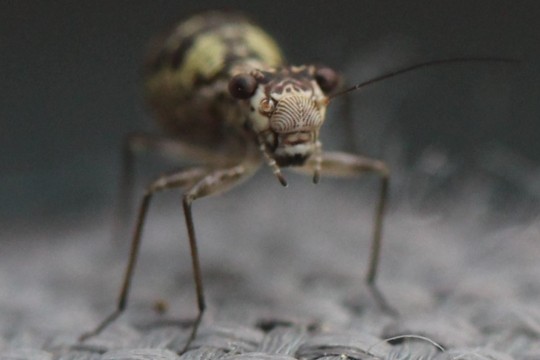
Before the day heated up too much, I wanted to get out and hike along one of Algonquin Park’s trails. I headed off for the Spruce Bog Boardwalk trail with my camera equipped with macro lens for the little critters I hoped to find. The Boardwalk extends through a bog, the dry-green plants concealing the water below. Tall and thin Black Spruce trees are the only trees able to survive in the acidic conditions here, and they form a patch of woodland through the middle section of the trail.
Upon entering the woods, I spotted a flash of orange among the bark. The source was a Compton Tortoiseshell Butterfly (Nymphalis l-album), showing glimpses of the beautiful orange dorsal side of its wings and then closing them again, looking like an extension of the tree trunk.


Within the woods, I encountered many less savoury insects, such as the mosquitoes and deer flies that sought my flesh and blood. Their assaults convinced me to move fairly quickly through the humid air, when I wasn’t bearing their attacks to focus the lens on some beautiful insects such as the red-lined leafhoppers (Graphocephala) that appear more tropical than temperate in nature:

I also happened upon a robber fly (Family Asilidae) perched on the edge of an overhanging leaf:
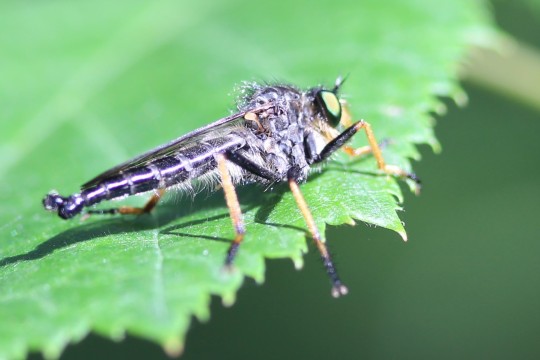
While crossing a boardwalk with a wood railing, I noticed something projecting downward from the lower surface. It was an egg case, placed there by its producer: a spider with the scientific name Theridiosoma gemmosum:


Once back in the sun, the attention of the deer flies and mosquitoes thankfully waned, and I came upon the patch of wildflower meadow that borders a turn in the trail. There I was able to photograph many insects among the array of flower petals. There were Tachinid Flies, a group of flies that develop as parasitoids (parasite-predators, see “Close Encounters of a Wasp Kind”) inside of other arthropods. A wonderful bundle of gold-and-orange colour bounded from flower to flower, and I managed to capture its image: that of a Tri-coloured Bumble Bee (Bombus ternarius). Also present was an insect that straddled the worlds of bee and fly. The Orange-legged Drone Fly (Eristalis flavipes) appears to be a bumblebee but is in fact a fly, that simply mimics the bumblebee’s shape and colour pattern, down to the golden fuzz on its thorax.

A Tachinid fly traveling over flower petals.
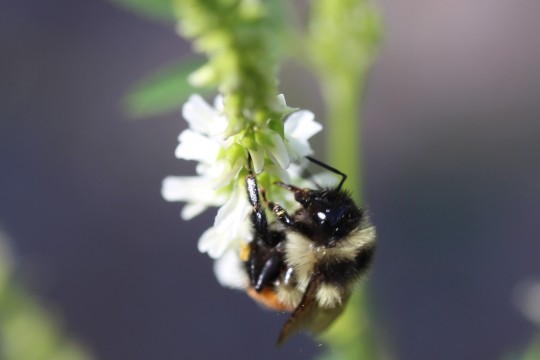
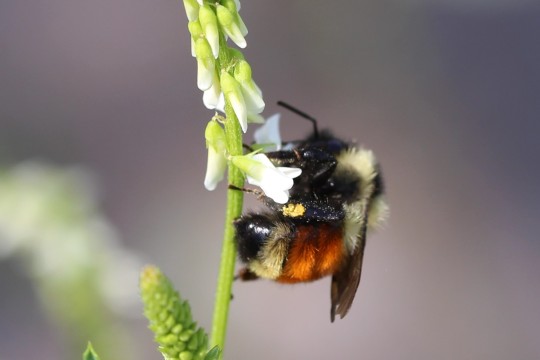

Bumblebees do not sit still for very long.
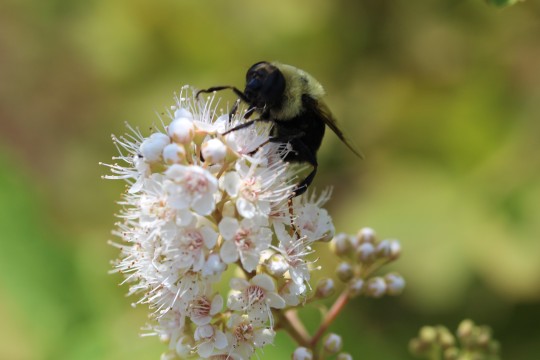
A Bumblebee-mimicking fly: the Orange Legged Drone Fly (Eristalis flavipes).
Why mimic another creature? Why not look distinct as so many other insects do? Most likely the fly is afforded protection by looking like a stinging bee, rather than like a ‘harmless’ fly, though I knew just how harmful flies could be thanks to the gouging mouthparts of the deer flies I had recently escaped.
Among these flowers I found another of the Compton Tortoiseshell butterflies, no longer hiding on the trunk of a tree, but beautifully spreading its orange wings to the sun:

Leaving the wildflower meadow behind, I continued down the last leg of the trail, which was rather sandy. Though I had left most flowers behind, I did manage to capture a few more beautiful insects on my camera. One of which was another bee-mimic, though to my eyes a much less effective one than the Eristalis. This fly was a member of the aptly named bee-fly family (Bombyliidae) and was probably another parasitoid like the Tachinid fly:
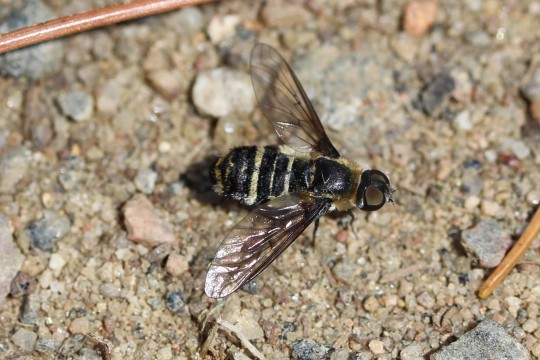
As I crouched to take the picture of the bee-fly on the sandy path, a small butterfly landed delicately on a flower right in front of me. The opportunity felt too good to be true, but I thankfully was able to train the macro lens upon its silvery wings before it fluttered off mere moments later. The butterfly was a Bog Copper (Lycaena epixanthe), an appropriate finale for my tour of the Spruce Bog trail:

After visiting the Algonquin Bookstore, and perusing the many tempting titles, I headed back to my campsite, before my wife and I decided to go for a drive. We went down the Opeongo Road, a good road to spot wildlife, as it is surrounded on both sides by woodlands that give way to wetlands. Any area that is a transition between two habitat types is a great place to view wildlife from either habitat. We were rewarded with probably the most iconic animal of Algonquin Provincial Park in plain sight: the imposing and wild Moose (Alces americanus). The male Moose (as evidenced by the protruding antler stubs above his ears) waded through the water, cropping vegetation with its powerful lips and teeth, lifting its large head to gaze around solemnly as it ate.
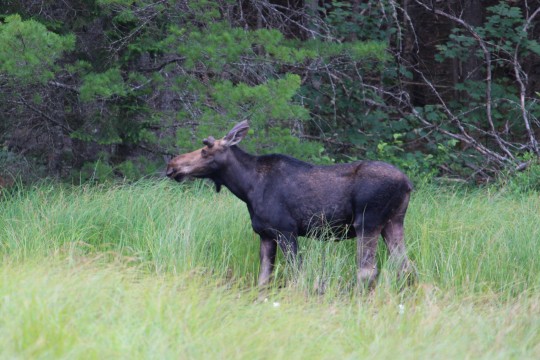
A fitting end to our observations during our first full day in Algonquin Provincial Park.
6 notes
·
View notes
Text
A nice peaceful day at the park and the Danger agency's top agents and power couple, Danger Mouse and Penfold, decide to relax spend some time with little Jackie.
Danger Mouse is eagle-eyed and looks at Jackie at all times to check if she's ok- Not at all parnoid (yeah, right)
"Danger Mouse, I think it's best to just let Jackie do her own thing, she'll be ok" Penfold advised
"What if she hurts herself? I need to check if she's ok, especially after this morning!" DM panics a little
"Honey, that was just a papercut" Penfold said, for once being the reassuring one and Danger Mouse being the worrying basket case
"Yeah, but she could've gotten it infected. She's delicate, you know?"
Penfold simply sighs
"I'm sure she'll be fine, just stop staring at her- it's getting kind of weird"
Danger Mouse struggles, but eventually gathers the courage to leave Jackie alone
"Ok, I guess you're right. I'll admit it, I can be overprotective of Jackie at times..."
At times? That's understating it, don't you think?
"...Which is weird and so out of character for me" DM sighs
"No, it's not..."
Penfold kisses Danger Mouse
"...It's sweet that you care about her, you're her dad! But you need to know when to let her go"
DM simply nods
"Hm-mm"
DM tries to relax and sit next to Penfold.
Meanwhile, Britain's favourite cutie-pie, Jackie decides to wander around the park, noticing that her dad isn't weirdly staring at her
"Good grief" Jackie exclaims, almost mimicing her father saying that,
She starts by playing football (soccer for you American readers) on her own, or rather, with her favoured teddy, Miss Marshmallows
She placed two stones across each other, forming a goal and placed Miss Marshmallows in the middle of the two stones as the goalie
Jackie places the football between her and the 'goal',
She goes for a good run-up, kicks it and it flies over and past goalkeeper Marshmallows into a small forest of trees,
At first Jackie was hesitant to go in, but plucks up enough courage to go after it into the unknown (this will end well).
"You're right Penfold, Jackie is fine, there really is nkthing to worry about-"
"OW!" a voice echoed from nearby
Danger Mouse jumps up, ready for action
"That could be anyone" Penfold tries to reassure him
"No, I can tell by the pitch, tone and accent, it was Jackie!"
DM dashes to Jackie, who was in the
Jackie ran out the small forest as soon as she could, her finger felt a sharp stinging sensation
"Jackie! Muffin, what's wrong? Are you hurt? What happened?" DM panics, spiraling into multiple questions
"Daddy-"
"Did someone hurt you?"
"Daddy..."
"Who was it?"
"Daddy! Calm down" Jackie snaps
"...sorry" she quickly adds
"PENFOLD! JACKIE'S HURT HERSELF!" Danger Mouse calls for his husband's help, embarassing poor Jackie (and Penfold) a little
Penfold rolls his eyes and walks over with the first aid kit,
"Ok, Danger Mouse, chief, honey, sweetheart, my love, THERE'S NO NEED TO YELL!" Penfold loudly informed
"Now, where does it hurt?" Penfold asks his daughter calmly
Jackie points to her finger,
Penfold carefully spots a small (but painful) splinter
"It's just a splinter..." he says to Danger Mouse, not amused by his overreaction
Penfold gets out the tweezers
"Careful" Danger Mouse quietly panics
Penfold rolls his eyes once again and struggle at first and getting the tweezers to grab the splinter in the pup's finger
"Is it stuck in there?" DM (rudely) disturbs
"It is pretty deep in there, but I got it."
Penfold tried again and even herder this time and evetually yanks it out, Jackie yelps quietly
"You ok, sweetheart?" Penfold asks and Jackie nods,
Danger Mouse scoops Jackie up in a hug as if her life had been saved
"Daddy, I'm fine" Jackie moans in slight annoyance
"Good grief" she says, once again mimicing her dads when they say it
"I know I know, I just get so worried about you because I love you so much"
"It's ok, daddy, I'm ok" Jackie smiles
"...so, would you freak out if I told you a wasp stung me as well?"
"Oh my goodness, where?!" Danger Mouse starts to panic again.
🌟🌟🌟🌟🌟🌟🌟🌟
Thank you, @djfunko for your help yesterday!!💖💖💖💖👍👍👍
#danger mouse#penfold#oc#jackie penfold-mouse#jackie the pup#ernest penfold#dm#danger mouse 2015#fanfic#fanfiction#fanfictions#fanfics
6 notes
·
View notes
Text
Crystal clear: Lepidopterans have many ways of being transparent
https://sciencespies.com/nature/crystal-clear-lepidopterans-have-many-ways-of-being-transparent/
Crystal clear: Lepidopterans have many ways of being transparent
Butterflies and moths have beautiful wings: the bright flare of an orange monarch, the vivid stripes of a swallowtail, the luminous green of a Luna moth. But some butterflies flutter on even more dramatic wings: parts of their wing, or sometimes the entire wing itself, are actually transparent.
Many aquatic organisms, including jellies and fish, are transparent. But transparent butterfly and moth wings are so arresting that merely catching a glimpse of one typically causes a human to lunge for a camera or at least point it out to their friends. These enigmatic, transparent butterfly wings have not been studied comprehensively.
Doris Gomez and Marianne Elias (French National Center for Scientific Research) set out to change that. Last week, along with a multidisciplinary team of ecologists, biologists and physicists, they published a massive survey on the optics and ecological implications of moths and butterflies with transparent wings in the Ecological Society of America’s journal Ecological Monographs. They discovered that transparency has evolved in Lepidoptera more than once, and that there are many ways to be transparent.
Gomez, an ecologist who has studied the physics and ecological aspects of iridescence in hummingbird wings and other bird coloration, was intrigued by these so-called “glasswing” butterflies and moths when she met Elias, an evolutionary biologist who worked on the ecology and evolution of the tropical butterflies Ithomiini, which have transparent wings. Gomez was startled to find that almost nothing had been written about transparency in Lepidoptera, nor in any other terrestrial animal.
“This paper is a breakthrough because everything that’s been known so far on transparency was about aquatic organisms,” Gomez said. “Transparency is so rare in terrestrial organisms that people never bothered to study it comprehensively.”
She and her team analyzed 123 species of Lepidoptera from samples in the French Museum of Natural History’s collection. They found transparency, or “clearwing” species, in 31 out of 124 families. But not all species accomplish transparency in the same way. They examined the extent to which transparency affects thermoregulation and provides protection against ultraviolet radiation.
advertisement
Many insects, including wasps, flies and dragonflies, have clear wings. Their wings consist of a transparent membrane made of chitin. Butterfly and moth wings are made of the same kind of transparent membrane, but in most cases moths and butterflies have opaque scales obscuring the membrane. The scales are what are responsible for their mesmerizing patterns and coloration.
Gomez and her team discovered that clearwing species have a number of ways to make their wings transparent. Some transparent moths and butterflies have no scales on their wings at all, leaving the chitin membrane to show through. Many other species do have scales, which can be transparent, upright, narrow or hair-like, allowing light through the wing.
Physicists have studied instances of transparency in individual species or genera, in the hopes of understanding the physics of how to adapt biological concepts to make people, vehicles and even structures invisible or transparent. But before now, no one had appreciated the wealth of approaches lepidopterans can take to achieve transparency, or the fact that it has evolved multiple times in different groups.
“This is the first comparative analysis of transparent butterfly wings,” said Elias. “What is notable is that transparency has evolved several times independently. But the way the wings become transparent can be dramatically different, from highly packed transparent scales to the mere absence of scales, through scale reduction in size and density. There are many ways of being transparent. We don’t know why this diversity exists.”
In some cases, different strategies lead to the same level of transparency, leaving researchers pondering why such diversity exists at all. They theorize that transparency may be beneficial in different ways for different species, including as camouflage or to mimic wasp and bees. Transparency also seems to help moths and butterflies regulate their body temperature, but does not protect them from UV radiation.
Gomez, who has a passion for working with scientists from across other disciplines, included physicists in the study to explore the optical properties of the wings including discerning what birds, their would-be predators, see when they look at a transparent butterfly. They found that the more light that can pass through a wing — i.e., the more transparent it is — the less visible the butterfly is to predators. Transparency acts like the ultimate camouflage.
Like the butterflies themselves, the results are compelling. However, the scientists emphasize that the study has raised more questions and avenues of exploration to continue to uncover the evolutionary role and ecological implications of transparency.
“Butterflies are such iconic organisms,” said Gomez. “They’re so wonderful to study. I like to study complex concepts, like iridescence and transparency because there is so much to explore — and it’s so easy to get everyone excited about them.”
#Nature
1 note
·
View note
Text
BUG HOTEL- UPCYCLING AND ENVIRONMENT
POLLINATORS
In addition, I decided to make something out of old scaffolding. My mum had them in the garden as a shelving unit with ornaments and spare plant pots in. Although not wasted, I felt it could be better utilized to employ the positive encouragement of up-cycling.
After careful consideration it was decided to revamp them into a multi-leveled bug hut. Painting them in wood paint to liven them up and also make them attractive to insects who are attracted to bright colours. The paint is also non-toxic so won’t harm them.
Once the paint has dried, the construction followed by filling each section with different natural materials. Such as: twigs, pinecones moss and bark. The remainder were filled with old spare bricks, canes and plant pots.
Providing shelter and safety to a variety of inhabitants and encourage a thriving habitat.
The RSPB website advocates the use of the following items :]
dead wood and loose bark for creepy crawlies like beetles, centipedes, spiders and woodlice
holes and small tubes (not plastic) for solitary bees made out of bamboo, reeds and drilled logs
larger holes with stones and tiles, which provide the cool, damp conditions frogs and toads like – if you put it in the centre you’ll give them a frost-free place to spend the winter (they’ll help eat slugs)
dry leaves, sticks or straw for ladybirds (they eat aphids) and other beetles and bugs
corrugated cardboard for lacewings (their larvae eat aphids, too)
dry leaves which mimic a natural forest floor
https://www.rspb.org.uk/get-involved/activities/give-nature-a-home-in-your-garden/garden-activities/build-a-bug-hotel/
Finally, adding a roof to allow them to stay dry. This bug hotel was one of the first creations in the garden. Over the last few weeks I have observed more wildlife in the garden. Particularly in the sections with canes, which have housed loads of solitary bees who have began to build nests. In the pinecone area with tiles loads of spiders and centipedes are present.
This creation is mutually beneficial it gives the children a learning opportunity to explore wildlife closely and safely also gives a haven to the wildlife which may otherwise have no habitat to thrive. During the rainy periods it has given shelter to the bees that have housed in the tubes.
The above elements create an emphasis on the creative freedom that up-cycling allows you. Which could potentially inspire you to put your own creative personality in perhaps your own garden; adding a splash of color to the landscape.
Both the tyre planters and the bug hotel are built for the purpose of encouraging wildlife, insects and ultimately pollinators. The emphasis on the importance of pollinators is crucial for our survival.
EVIDENCE - RHS BOOK poliantors quotes.
The importance of conserving these environments is previlant now more than ever and is reciprocally favorable to everyone. Supporting the philosophy further regarding participation and community and expanding further into our environment. Putting emphasis on protection and maintenance of habitats which are becoming endangered and are also vital for our own survival.
Encouraging children to create their own ‘minibeast hotels’ also adds an additional element of pride. Allowing them to visually seeing the fruits of their labour.
BEES BUTTERFLIES MOTHS AND POLLINATORS.
And solitary bees are also …
BUG HOTEL/ BEES AND POLINATORS
my bug hut


194
“insect pollinators including bees and moths are in decline but you can help them by creating an attractive habitat for them”
“We rely on pollinators for the majority of our food crops, yet pollinating insect pollinators are in trouble. You can help to boost their falling numbers by making your garden a little patch of pollinator paradise that meets their needs. Attract pollinators with pollen-baring, nectar rich flowers that bloom with different times of year, and night scened plants and larval food plants for buttlerfly and moth caterpillars and provide plenty of places for pollinators to shelter”.
“ Studies show that pollinators are disappearing fast, with up to 50% of all bee species threatened in some European countries due to loss of habitat, changing climate, spread of pests, disease and pesticides being contributing factors”.
3 species of bumble bee are now extinct in the UK.
In the Uk alone, more than half the butterfly and moth species have declines over the past 50 years.
Moths ( elephant hawk) like red companion and they are important pollinators.
195
Plants like strawberry and beans need pollinating.
Crutiial role for pollinators honey bee pollinates 70% of around 100 crop species that feed 90% of the world.
Field beans and clover which feed live stock for meat and milk.
If pollinators disappeared, so would many of the plants that rely on them exclusively for pollination
Urban gardens in Europe and North America can support higher density of bumble bees and solitary bees than farm land,
You can help pollinators by using plants to attract these important insects to your garden
Most pollinators are bees, flies, wasps , beetles and butterflies and moths.
They pollinate the edibles in our gardens
196
how to help pollinators
an ohs study of insects visiting garden plants in the UK found that the best way to grow a mixtuer of native, northern and southern hemisphere plants.
go for variety - pollinators are attracted to different shapes of flowers, so it makes sense to choose a range of sizes and shapes. Scientists are still researching why certain plants are more attractive to insects.
Hoverflies prefer flat ion flowers e.g angelica
Plants with tubular flowers, such as foxgloves are more likely to be visited by insects with a long proboscis eg. butterflies, moths and some bumble bees.
Vegetable gardens attract pollinators with the flowers of borage, chives mint, rosemary and sage.
Place in the sun-
pollinators, especially butterflies prefer flowers in sunny spots. This is partly because sunshine can affect nectar production and also perhaps because insects don’t need to expend as much in warm energy conditions.
Try to provide nectar all year round.
February to October when pollinators are more active.
THEY ADVISE Multi story bug hotel. For insects made using natural materials will provide shelter for all types of mini beasts.
197- pollinators and other invertebrates can overwinter in. Solitary bees like to nest in hollow plant stems or bamboo canes. 1.5-2 cm in diameter and 10-20cm long.
avoid pesticides.
invisible colors - it pays to include a range of hues in your garden beaucse of certain colurs, while pleasing to us, are less appealing to some pollinators.
Studies have found that red for instance, is generally less attractive to insects.
Bees- and insects with good vision - see better in the value spectrum and beyond into the UV range.
Many flowers have UV markings on them , which are invisible to humans but appear differently to insects.
Scientists think these markings act like landing strips, guiding pollinators to nectar and pollen.
!98 Wild flower meadow
Meadows full of different kinds of flowers and grasses are home to, and feeding grounds for many kinds of insects. These insects, in turn, provide food for birds and small mammals.
They have disappeared from the country side.
You can help revive these habitats by planting a mini meadow in your own green space.

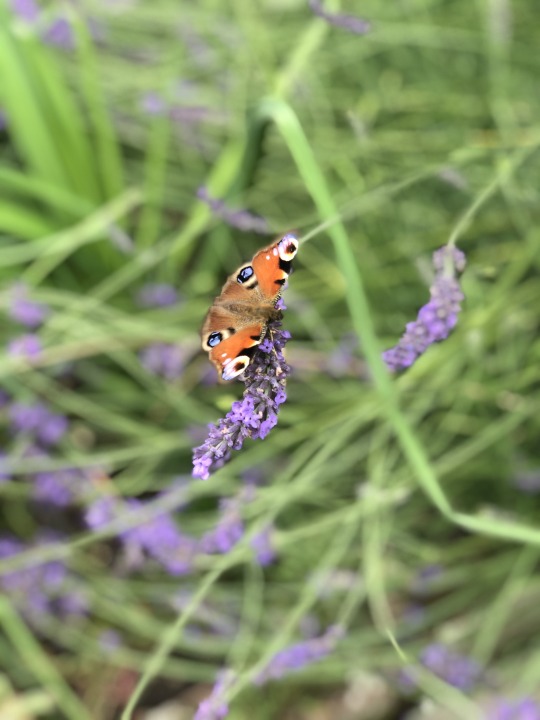

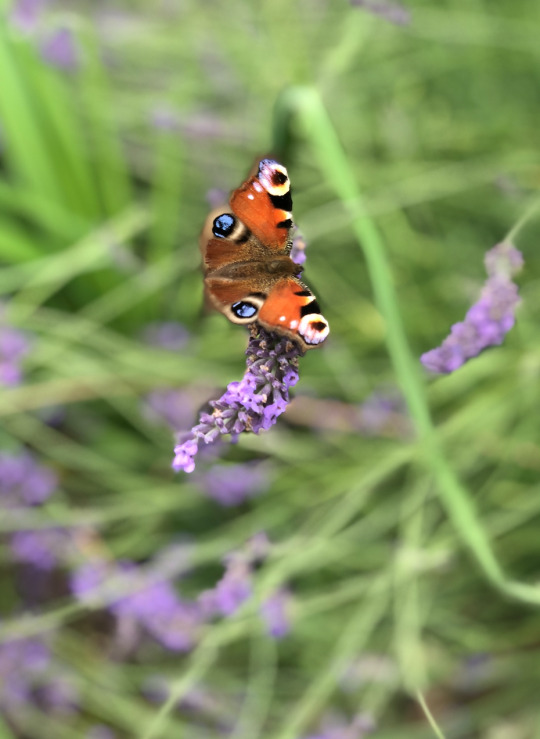
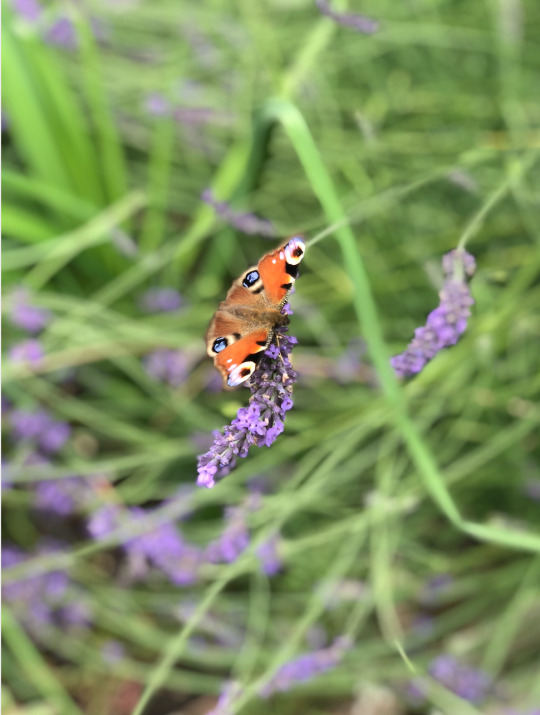




0 notes
Text
On the Necessity of Limitations and the Joy of Collecting

In the summer of 2015, I took a trip to Hocking Hills, Ohio, a hidden Midwestern treasure. When you show people pictures of the incredible caves and waterfalls, they are understandably skeptical that such a place is found in Ohio. It is a wonderland of natural architecture. And it was here that I had a memorable first encounter. Descending a long staircase near one of the many waterfalls, I saw the people in front of me veer to one side, avoiding something on the wooden railing. The something is pictured above.
To the incredulity of my girlfriend and the others who passed us, I did not hesitate to approach and pick it up. Two large compound eyes, and a set of only two wings: this was not a wasp, but a fly. I sat down to let the creature continue its feast on beads of sweat, and thrilled at the fact that I had found my first hoverfly, a member of the family Syrphidae, a group of fantastic mimics. The humans veering to one side on the stairs were reacting exactly as they “should,” based on the evolutionary tactic of the family. These flies are harmless, and have no way to sting, but mimicry of more dangerous species allows them safety from predators.
I fondly recalled this first hoverfly when reading the first book I finished in 2017, The Fly Trap, by the Swedish entomologist Fredrik Sjöberg, who specializes in these insects. Sjöberg’s book, though—to use a hackneyed phrase—is as much a book about hoverflies as Moby Dick is a book about whaling.
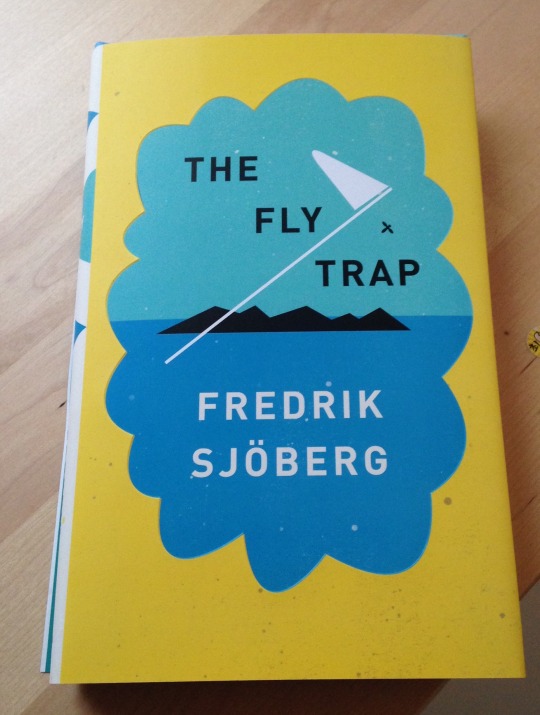
The Fly Trap is a personal memoir, a book by turns charming and heartbreaking. Sjöberg gives us the surface details of his life in such a way that we constantly hear something humming below. To read the book is to attune your senses just a little more to the metaphor and meaning underlying mundane circumstances. At first glance, the book is about a career spent loving and pursuing hoverflies; but underneath all of this, the author pours themes into his book. “Anyway, the hoverflies are only props,” he writes. “No, not only, but to some extent. Here and there, my story is about something else. Exactly what, I don’t know.”
We may each find our own list of themes that move us in the book. There is the theme of aimless travel as a way of trying to tame an overly romantic heart, and how often the author found himself “running away” from entomology, a profession he admits can be lonely, and one which doesn’t often appeal to the ladies. There is the theme of the value of slowness [“A theme granted me by nature. Which is probably just an unjustifiable simplification, a mental wild-goose chase, a poetic paraphrase meant to make a virtue of, or hide, a genetic inability to deal with choice.”]. There is the recurrent theme of how awkward our passions, so clearly vital to our own lives, can seem to others: he relates the embarrassing and often ridiculous encounters with strangers while out chasing and studying hoverflies.

Most significant to me, he composes a thematic ode to limitation. Using the metaphor of islands—for Sjöberg lives and studies his hoverflies on a Swedish isle—he celebrates the things that compress and contain us, thereby giving us the energy to live more fully. Referring to the window of time one has after planning an important trip, but before departure, Sjöberg writes:
“When the days are numbered, everything seems clearer, as if the time between preparation and departure possessed a particular magic. The endless stretch of time on the other side always struck me as evasive and treacherous. But the very limited period between now and then held a liberating peace and quiet. This allotment of time was an island. And the island became, later, a measurable moment. For a long time, this discovery was the only truly unclouded dividend that I took from my travels.”

Sjöberg finds island everywhere. He writes of the “irrepressible urge of curious boys to explore islands, even where islands don’t exist. Or, to be more exact, where islands are not to be discovered without the creative imagination that characterizes artists and good scientists.” It is the mind of an artist and scientist which elevates limitation to an art. While some may want to devote their lives to covering as vast and broad a selection of interests as possible, to drink in as much of the world as one can, the author is praising the study of minutiae, of counting every species of hoverfly, not in the world, but on his Swedish isle. The limitation brings a new glow to what we pursue, in the same way that a greater feeling of accomplishment can come from setting manageable goals, a way to avoid the feeling of being overwhelmed by the immensity of the tasks we have to accomplish.
Sjöberg is a hopeless romantic—and one of the most charming kinds, for instead of constantly laying his heart out for the reader, he flirts with us, only offering glimpses of a tender heart in the midst of longer, staid passages. How many times have I fallen into a mood of hypersensitivity to the emotional life, and wandered into a bookstore at night, where there are pools of light over books whose covers I brush with my fingertips, hoping that some author might befriend me in the way Sjöberg has? Sjöberg, in what seems a similar mood, finds pleasure in pursuing the lives of ordinary people. He chooses in the Fly Trap to focus on the Swedish entomologist who invented the Malaise trap for catching insects: René Edmond Malaise. He confesses a desire to chronicle the lives of underdogs, and in treating Malaise as a heroic figure, his task is similar to Alain de Botton’s narrator in Kiss & Tell: to make an epic of ordinary life, to see metaphor in the actions of another, and to see one’s own life projected onto theirs. This is another way of returning to The Fly Trap’s theme of limitation: to choose not the most famous of culturally significant of figures, but to show the curiosity and strangeness of the life of a forgotten man. Not only does this allow Sjöberg to do much research in an area where biographers aren’t profuse, but it also allows him to dedicate himself more fully to the more limiting constraints of studying a man whose biographical details are more scant. Just look choosing to study something as specific as hoverflies, he chooses to study a specific man’s life. There is sadness and beauty in the way the author follows Malaise through all of the details he uncovers: his ups and downs, his entomological success, his mysterious travels, and even his later crackpot theories about the island of Atlantis. To read Sjöberg’s pursuit of Malaise is almost like reading a detective novel; there is an energy and pace to the uncovering of Malaise’s life, and I forgot more than once that Sjöberg was studying an actual, historical person.

Returning to another theme we’ve talked about in regards to Alain de Botton’s The Romantic Movement, The Fly Trap celebrates the art of collecting. Using the term “buttonology” to refer to the exhaustive collection that someone with this near-manic hobby desires, the author writes: “The idea is to be exhaustive, to include everything. In this way, the buttonologist differs from the mapmaker, whom he resembles and can easily be confused with. But the person who makes maps can never include everything in his picture of reality, which remains a simplification no matter what scale he chooses. Both attempt to capture something and to preserve it. And yet they are very different.” Sjöberg speculates uneasily that perhaps the buttonologist is an erstwhile mapmaker on his way to madness.
The desire to collect exhaustively is present in some minds more than others, but seems to be a somewhat universal human trait. How many hours have been plagued by the anal-retentive desire to perfect a collection? I’ll be more direct: How many hours have I spent poring through my collection of books, hoping to perfect it as a symbolic representation of who I am? How many hours have I spent collecting leaves, as though the trees themselves could not be seen if I did not press their leaves into my notebook? Sjöberg speculates on what motivates collectors and completionists to go to the lengths that they do: “The German-American psychoanalyst Werner Muensterberger has pointed out that many collectors collect to escape the dreadful depressions that constantly pursue them… in a form of fetishism that does indeed allay anxiety.” However, Sjöberg draws a line between artificial and natural objects, and says that natural objects are not fetishes in the same way: “One reason is that they can seldom be purchased for money. In addition, they almost always lack cultural provenance.” To collect leaves, then, is to Sjöberg a healthier obsession, and, we might add, one which also serves to connect us more viscerally to surrounding nature, arguably something every human being needs for a sense of well-being. It’s simply a task of learning when to use the energy of collecting, and when to let go and remind ourselves of a more fundamental sense of being.

In celebrating limitation, in choosing a single biography to focus on, in choosing a single family of insects to study, in choosing to find islands in all of the circumstances of life, Sjöberg is also writing about control. “In exercising control over something, however insignificant and apparently meaningless, there is a peaceful euphoria, however ephemeral and fleeting,” he writes. His book is also about the tension between his sensitive heart and the control he tries to gain over it. Perhaps sensitive and emotionally-driven people are more likely to collect as a means to focusing energy into something constructive (no matter how practically useless the collection, or how futile the goal of collecting exhaustively), a means of curbing excess of heartache and finding purpose, and so positivity.
Finally, there is a sudden, heartrending beauty to many of the passages in The Fly Trap. “Purple loosestrife sways in the light sea breeze. The heavy smell of seaweed. Arctic terns!” exclaims a man in love. Or, in closing, take this heartfelt reverie on the color of maple blossoms in the spring:

“The colour alone puts me in a good mood. Maple blossoms are greenish yellow, and the tender leaves a yellowish green—and not the other way around. From a distance, the mix of these two tones creates a third so beautiful that the language lacks a word to describe it. As we all know, greenery deepens in colour as summer comes on, but the blooming of the maples is when it all begins, when everything is at its brightest and best. Just a week, maybe two, and then the alders burst into lead in deadly earnest. I wish so profoundly that everyone knew. ‘Maples blossoming.’ Those two words on answering machines would be enough. Everyone would get the message. They’d see the colour, sense its nuance, understand. Know then that everything flies, absolutely everything. A thousand commentaries. An entire apparatus of footnotes.”
(Credit to Dana Ocker for the 3rd and 7th images. http://www.domediaart.com )
Sjöberg, Fredrik. The Fly Trap. 2004. Translated by Thomas Zeal, 2014. Vintage Book edition August 2016. Vintage (Penguin Random House LLC), New York. 278 p. $17.00
1 note
·
View note